PowerLabs Nitrocellulose Synthesis

PowerLabs Nitrocellulose Synthesis |
 |
|
|
Also known as "Cellulose Nitrate",
"Collodion Wool", "Soluble Gun Cotton", "Iodion
Cotton", "Pyroxylin", "Colloxylin"
"Xyloidin", "Celloidin" "Parlodion",
nitrocellulose is a product that has found many uses on everyday life. It is a
white, yellow or transparent
plastic, which can be anywhere from brittle to flexible. Nitrocellulose (mainly C6H7N3O11)is used to make anything from Smokeless Gun Powder
(also called Triple Base, due to the addition of nitroglycerine, nitroguanidine
flash suppressor and burn rate catalysts), Double Base
(DB) solid rocket propellants (with 30 - 50% nitroglycerine added to result in a
perfect oxygen balance), to
waterproof fuses in pyrotechnics, inks, adhesives,
varnishes, resins, lacquer coatings, embedding sections in microscopy,
photography, electro techniques, galvanoplasty, and even certain plastics,
such as what is used in ping-pong balls. It can have properties ranging from a strong, resistant
plastic to an unstable class B (highly flammable, explosive when confined)
explosive material, all determined by the nitrogen content...
Here the procedure for making nitrocellulose are outlined with the sole
intent of scientific information. Although it is one of the safest nitration
procedures (there have been no reported cases (at least that I am aware off)
of incidents occurring during manufacture), and the cellulose nitrate produced here
is of a lower nitrogen content (the plastic tetranitrate, as opposed to the
explosive hexanitrate), the products do require expert handling, and even though
it does not constitute in a very big explosion hazard, the
procedure requires the handling of concentrated Sulphuric and Nitric acids, as well as
highly
flammable Acetone, which make it very hazardous for anyone unskilled with
chemistry to attempt. Once again I discourage anyone to attempt these
procedures, and if you choose to do so you are doing it at your own risk.
|
Reactants: |
Materials: |
|
98% Concentrated Sulphuric Acid (H2So4(l)) |
Two clean glass beakers |
|
70% Concentrated Nitric Acid (HNO3(aq)) |
Pipette |
|
Pure Cotton (90% Cellulose, C6H10O5(s)) |
Stirring Rod |
|
Acetone ((CH3)2CO(l)) |
|
| Distilled Water (l) | |
Sodium Bicarbonate (NaHCO3(s)) |
|
For trinitrate the formula is as follows: C6H7O(OH)3O + 3 OHNO2 --> C6H7(ONO2)3O + 3H2O
Here all the materials and reactants needed for the
synthesis of nitrocellulose can be seen: From the back row to the front, from
left to right: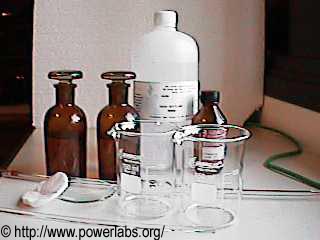
100mL bottle of 98%Conc. H2So4, 100mL bottle of 70% Conc.
HNO3, 1L of Distilled Water, 100mL of Acetone.
10mL Glass pipette
0.5g cotton pad, 2X 150mL Pyrex glass beakers
Glass stirring rod.
For this procedure 5ml of 50 - 50% (by vol.) nitrating mixture was prepared, as seen below, and to it the .5g cotton pad was added. The cotton was allowed to nitrate for five minutes at room temperature, while stirring.
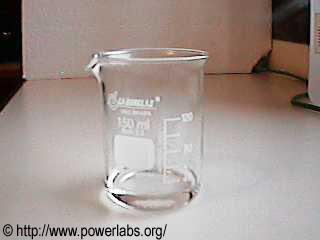
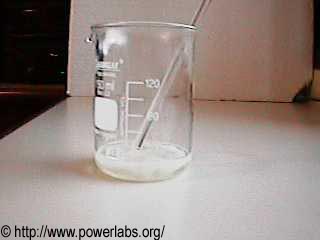
The cotton was than washed once in saturated sodium bicarbonate solution and 2 times in distilled water, until the leftover water tested neutral. It was than allowed to thoroughly dry and dissolved in acetone.
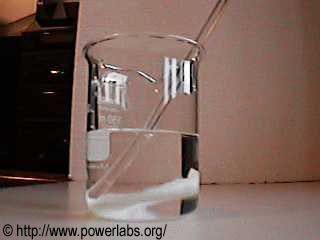

The acetone was than allowed to vaporize until a concentrated syrup-like nitrocellulose lacquer formed. A small bit of un-nitrated cotton was than removed, and the rest of the acetone was allowed to dry.
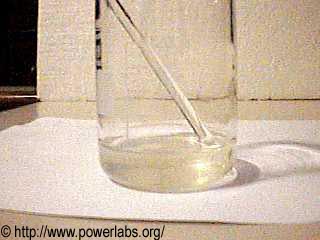
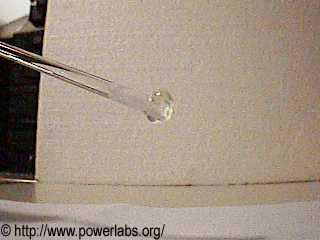
Below a dry cylinder of nitrocellulose can be seen. Notice how it has taken the shape of the beaker and how it formed thin sheets of NC that were smeared on the sides of the beaker: those thin sheets are a material very similar to what is used in guitar and other resistant, high gloss coatings... Next to it is a picture of the cellulose burning. It burns all at once, with a fast bright flame and a characteristic "phomp!" noise as the gas expands. The yellow color is due to carbon in the NC molecule. Notice how it does not produce any smoke. There is, however some residue left, proof that this plastic is the product of incomplete nitration.

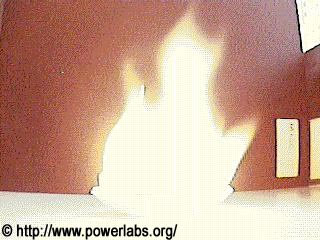
(For curiosity purposes only, POWERLABS outlines the method used for
making rocket-fuel and double base powder grade nitrocellulose.)
The procedure is very similar to the one outlined above, except it uses
a slightly different nitrating mixture. The proportions are now 35% / 65% (by
volume) for
HNO3 / H2SO4, assuming that the acid
concentrations used were the same as the ones used above. 5 parts of acid are
used for every part of dry cellulose (per weight). An alternate nitrating mix is
made by adding 1gram of finely powdered Potassium or Sodium Nitrate (KNO3/NaNo3)
for
every 3.325g (3.819ml) of cold concentrated Sulphuric Acid (H2SO4), and
than add cotton to this nitrating mixture when the temperature has stabilized. I
don't use this particular procedure
because it is hazardous (there is a lot of heat involved in the formation of
nitric acid by removal of nitrate from the potassium ion) and can cause
sputtering as well as releasing toxic fumes. Plus resultant mixture is not
only nitric and sulphuric acids, but also includes potassium or sodium sulphate, which
will have a negative effect on the quality of the final product.
Complete nitration takes about 10 minutes at room temperature. On a small
scale not enough
heat is evolved to justify an ice bath, which would only slow the process down.
The mixture with a greater sulphuric acid content is able to
impart more nitrate ions to the cellulose, causing it to have a much higher
nitrate (nitrogen and oxygen) content. The procedure is still reasonably safe to
perform from a stability point of view (meaning that it is virtually impossible
for the nitrocellulose to form upon formation),
but now the resultant product (when dry) burns
a lot faster, hotter, and releases much more energy than the trinitrate above.
It is, in fact, one of the most energetic deflagrants known, capable of DDT
(Deflagration - Detonation Transition) with 123-147% the
explosive strength of TNT when detonated at 7300 meters per second (Nitrocellulose
(13.35% N) max density 1.2g/cc).
NOTE: It is very important to thoroughly neutralize the nitrocellulose by boiling
it in NaHCO3
and in distilled water several times until it tests neutral. It is also recommendable to add 0.5-1% of Urea or
diphenylamine in fine powder form to neutralize any remaining
nitrogen oxides that could become acidic in moisture and
causing accidental ignition of the product.
This product can be stored safely under water or dissolved in acetone (NC
Lacquer).
Now I must say the warning. The nitrocellulose
produced by this method is EXPLOSIVE and can deflagrate or even detonate
violently on shock, friction, or spark when dry. These procedures are not to be
attempted, and are outlined here only for informational purposes.

Click on the frame sequence above to watch a short (146KB) .mpg video of a
3cm (1.2") 1gram fluffy nitrocellulose ball being deflagrated by flame. The ball
was merely sitting on top of a stand, as *ANY* confinement, even it being inside
an open jar, would have resulted in an explosion. The heat produced by this burn
is so fantastic that it could be felt over a two meters away (you should never
look directly at large deflagrations as the light emitted can cause damage to the
retina). Despite the fact that the camera was positioned 2 meters from the
flame, and that all adjustments were made to avoid the light flooding effect,
the camera still couldn't handle the flash that was made. The sound of the flame is a
low pitched thump, indicating a large, subsonic air displacement. Of course, due
to file size limitations a lot of the original sound and video quality were
lost.
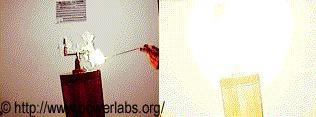 Finally,
you might have seen (or heard off) a product called "Flash paper" its
often used in magic tricks: A square piece of normal (white) paper that burns
quickly in a flash without making any smoke or leaving any residue. All it is is
a piece of nitrated paper, as per the above method. The picture here shows a
piece of nitrated toilet paper (around the metal stand) burning.
Finally,
you might have seen (or heard off) a product called "Flash paper" its
often used in magic tricks: A square piece of normal (white) paper that burns
quickly in a flash without making any smoke or leaving any residue. All it is is
a piece of nitrated paper, as per the above method. The picture here shows a
piece of nitrated toilet paper (around the metal stand) burning.
Note: Runaway nitration for nitrocellulose occurs at 70oC. Never allow it to go above that temperature while in a nitrating mixture. Never attempt to nitrate large batches at once as the increased heat output will invariably result in runaway.
Comments? Questions? Don't hesitate to e-mail me!
People have visited this page since 27/04/00
Last update 11/02/10
|
Copyright
� 2000-2002 by Sam Barros. All rights reserved. Removing any material from this site for display without consent from its author consists in an infringement of international copyright laws and can result in fines up to $50000 per infringement, plus legal costs. So ASK ME before you remove anything from here. |